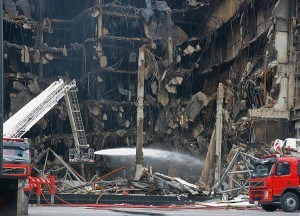

Ed Graf was given life in prison 25 years ago for killing his two stepsons by locking them in a backyard shed and setting it on fire. Two investigators used photos of the shed’s remains to persuade jurors that Graf had started the fire intentionally.
 By today’s standards of fire analysis, though, the investigators may have been mistaken.
By today’s standards of fire analysis, though, the investigators may have been mistaken.
Authorities in Texas and in other states are beginning to re-examine cases in which defendants were sent to prison for setting fires based on expert testimony about burn patterns and charring that today is considered suspect.
Nine years after Texas executed Cameron Todd Willingham for killing his three children in a fire – a conviction questioned by many legal advocates and fire experts – the state fire marshal and the nonprofit Innocence Project of Texas are working together to review the evidence in fire investigations and identify cases in which convictions might have been questionable.
Representatives will meet next month to start reviewing the first six cases, including Graf’s, who was convicted in 1988 of setting the deadly fire in the central Texas town of Hewitt.
It’s a rare collaboration between state officials and criminal justice advocates who are usually at odds.
“We both have the same goals, to make sure that justice is served.” said Chris Connealy, the state fire marshal.
The National Fire Protection Association issued its first set of fire investigation guidelines in 1992. Before then, fire investigators did not always use uniform procedures, Connealy said. Also, advances in scientific analysis have found other explanations for burn patterns once considered to be signs of arson.
The Innocence Project, a national legal reform group that has worked to exonerate more than 250 convicts, has identified potentially problematic arson cases in several states, including one in Tucson, Arizona, in 1970 in which 29 people were killed.
In Texas, which has had to free more than 100 inmates wrongly convicted in criminal cases, the state Innocence Project has narrowed its working list to about 60 arson cases of the 1,000 reviewed, chief counsel Jeff Blackburn said. A state expert panel, the Texas Forensic Science Commission, has also made 17 recommendations for improving how arson cases are handled.
The widespread attention given the Willingham case has driven interest in looking at other arson-related convictions. The Forensic Science Commission investigated the case for years, but was barred by Attorney General Greg Abbott from issuing a final report. Arson experts hired by the commission found the 1991 fire was most likely accidental.
It’s possible that problems will be found with more cases, Connealy said.
“Having been around fire investigations and being in the fire service the last 35 years, I saw where there could be improvements,” Connealy said in an interview. “I wanted to try to lead that effort to improving fire investigations. It should be based on science.”
If the group finds problems with an arson investigation, its findings will be sent to the authorities with jurisdiction over the case and to the Texas Court of Criminal Appeals, Connealy said. No action will be required, but the report could help someone who is wrongly imprisoned.
Graf is now a white-haired, 60-year-old man, who in a recent prison interview continued to maintain his innocence. Recent developments have given him new hope. Three experts consulted by his attorney, and one hired by the prosecution after Graf filed an appeal last year, have questioned the conclusions the original investigators drew from the fire scene photos.
“I know that there will be people that will never change their mind, and of course, there will be people that will,” Graf said. “It’s difficult for me to believe they can’t believe the science. The science, it’s pretty accurate now.”
State Deputy Fire Marshal Joseph Porter and New York fire investigator Charles King determined that charring was deepest near the shed entrance and on the doors. They pointed to “alligator” charring and other patterns to suggest a quick fire started by an accelerant like lighter fluid.
The experts consulted recently say those patterns could have been caused by a condition known as “flashover,” when a fire escalates to a point where the whole room is in flames. At flashover, deep burn patterns can appear all over a scene, regardless of where a fire started, according to the Arson Research Project, which examined the Graf case.
High levels of carbon monoxide found in both boys’ bodies could also suggest that an accelerant wasn’t used, the experts said. With an accelerant, the flames would have spread so quickly that the boys would not have lived long enough to inhale those fumes.
Several neighbors and other witnesses testified at the time of the fire that the boys had been seen playing with matches.
“The assumptions of `evidence’ upon which both men depended have no scientific basis,” wrote the prosecution expert, Thomas B. Sing, in a January report summarizing his findings.
King died in 2003. Porter could not be reached for comment.
Prosecutors support a new trial for Graf on the basis of the new analysis, but insist he is guilty.
Graf’s then-wife, Clare Bradburn, said she remains convinced he is guilty.
A final decision on a new trial is pending before the Texas Court of Criminal Appeals.
Connealy would not take a position on Graf’s innocence but wants to address any problems with old cases.